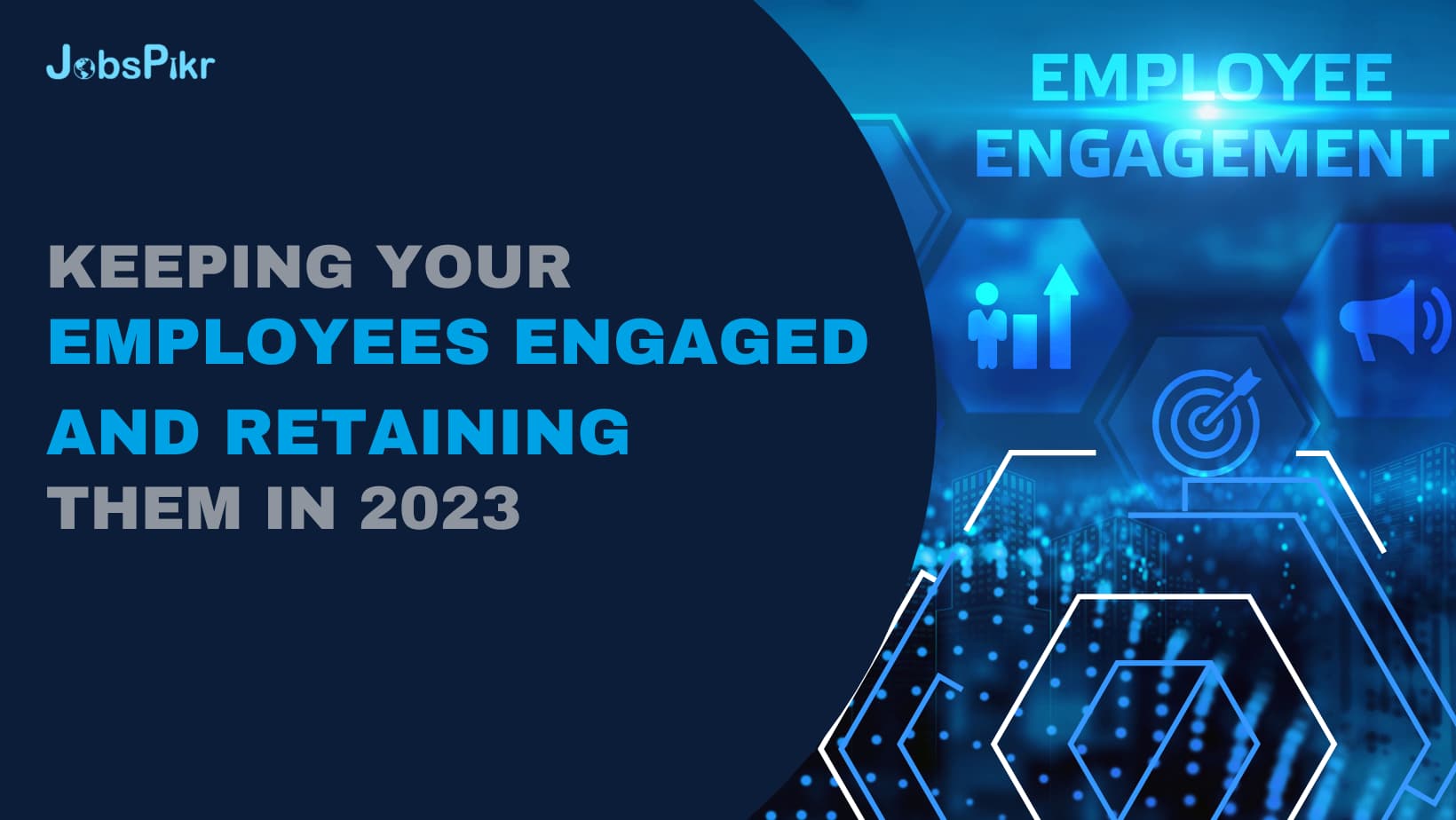When you search for “Employee Engagement”, the internet will come up with different definitions for the term. The definition differs depending on whom you ask, the employees, senior management or the HR personnel. The most widely accepted answer would be– An engaged employee is actively involved in the growth of a company. Such an employee doesn’t show up because he is paid to do so but because he or she takes a genuine interest in the work and the long-term goal of the company. A supportive organization with a healthy work environment can see better results with lesser personnel through higher employee engagement levels.
Employee engagement dropped for the first time in a decade to around 34% in 2021 as per this report by Gallup. Any drop in employee engagement would directly result in higher attrition rates, lower productivity among employees and lesser collaboration.
Some of the main benefits of employee engagement are:
1. Lower attrition rates: A company consists of people and processes. If people in important roles take an exit frequently, the company will not be able to achieve its targets. A higher engagement rate automatically converts to a higher retention rate in most cases. Companies with employees who feel like they are a part of the bigger picture are bound to succeed sooner or later.
2. Engagement Productivity: An engaged employee is more likely to perform the job better than one who is hanging by the string just because of the cash that enters his or her account at month’s end. Employees who believe in the company’s vision will be innovative and bring new ideas to the table to achieve better efficiency.
3. Engaged employees result in happier customers: A higher engagement means that employees care about the company and in turn, the customers. More content customers will automatically translate into more repeat sales.
4. Enhanced Company Culture and Free Marketing: Apart from the giants like Google, Microsoft and Facebook, there are also loads of small or mid-size companies that have cracked the code to successful business models. Many of these have a small but stable team with low attrition rates. These companies are often dream workplaces for millions. All this is without having spent a penny in advertising their work ethics. Due to this reason, when these companies occasionally hire, they automatically have access to the best resources since everyone wants to experience their work culture.
Keeping employees engaged can happen through multiple initiatives, some of which have been discussed below:
Recognition and Appreciation are a must
Managers and leaders need to recognise and appreciate the efforts put in by individuals. When employees go out of their way to-
- Work on something new or complicated.
- Pick up a learning task by themselves for better output.
- Provide support to teammates or new joiners.
- Work as a team player and take on added responsibilities that do not usually come with their position.
They need to be appreciated and rewarded. Recognition can be in the form of medals or public announcements but the most important point that has to be noted is– “you need to applaud in public and admonish in private”. That’s the only way to help your employees grow and contribute positively to the company’s bottom line.
Let employees bring about changes
Creative ideas brought forward by the young crowd are often shot down by senior folks who may not be receptive to change. These ideas can often result in changes that may prove beneficial. Ideas may involve-
- Automation of tasks to reduce chances of errors.
- Creating internal tools that address bottlenecks in processes.
- Using a coordinated workflow to attack certain problems.
- Analyzing historical and real-time data to make decisions.
Lending employees an ear, hearing them out and letting them work on improvements can bring about positive changes. The employees will feel encouraged and involved whereas the company will be leveraging new ideas and changes to remain relevant. Companies that have been running for years will have to adapt to the words– “Change is the only constant”.
Flexible Schedules
Not everyone may be available from 9 to 5, or be able to commute to work every day. Some may be living far from the office, others may have parents or kids to take care of. A more inclusive and diverse workspace where everyone can participate irrespective of their constraints will help everyone grow without feeling tied down. In the post-Covid era, where remote and hybrid work has boomed, companies need to allow flexibility for roles that do not require individuals to be at a certain location every day at a fixed time. This will give the companies access to a wider talent pool and more brilliant minds.
Small Gestures
Employee-friendly policies can take you a mile. Small gestures that feel personal can take you a hundred. These can vary from medical support during events like Covid to a small gift when an employee spends a certain number of years. Initiatives like CXO connect (where CXOs have lunch with one or a group of junior employees) can also help boost employees and lessen the gap that may exist between employees at different levels.
Keep the communication streams open
A tense work environment with a one-way communication stream is one with the least engagement. Leaders and managers should be approachable and should lend an ear whenever required. Unless the upper management is capable of “listening” instead of just “advising”, the employees will feel the disconnect and engagement levels will go down with time. If resources are lacking or a job is too difficult for an employee, the environment should be comfortable enough for him to be able to communicate this information. There can be no “fear” in a healthy work environment.
Invest in Employees
Companies need to offer opportunities for upskilling. Employees may often find themselves stagnating. To jump over the hurdle, and move forward, upskilling can be important. Upskilling can be done via online or offline courses. At times even the availability of subscriptions to certain websites may help individuals learn on the fly.
Upskilling helps in the personal development of employees, which would in turn boosts their productivity in the workplace- a symbiotic relationship. You may feel that if you help employees improve themselves they may leave. But what if you don’t help them improve or upgrade and they stay on and give a fraction of the output that they are capable of?
Regular employee feedback
Don’t wait for the appraisal cycles to give feedback to employees. That can make them feel disheartened. Instead, regular feedback can make employees feel more involved and they can undergo continuous course correction so that they are on track and aligned with the company’s philosophy and goals.
Encourage Autonomy as well as Teamwork
Autonomy should be encouraged. Individuals should be able to take a job from 0 to 100% on their own. If they get stuck in between, they should be able to take the help of their teammates or coordinate with other teams for inputs if required. This sort of autonomous work in a collaborative environment develops employees to be able to take on challenging tasks on their own without the need for oversight.
Leadership should be Encouraged
Leadership doesn’t always have to be attributed to managers. Leadership skills can also be picked up by someone with just a year’s work experience. Such individuals can shape their careers by starting to help others early on or by providing support to other teams. Often individuals are pulled into roles where they need to coordinate between internal and external members. These roles shape careers and also create leaders internally.
Promote Within
When you encourage leadership skills among the junior-most employees, you will find these individuals grow to occupy important positions. Internal promotions and putting employees who have spent years giving their time and energy to the company into leadership roles shall encourage other employees to give their 100% at work. It will also improve retention rates since younger employees will be able to see their path in the company.
Provide adequate tools and resources
You can’t dig a swimming pool with a shovel. Well, you could, but it would end up taking far too long. Similarly, if the employees at your company aren’t given adequate tools and resources to complete their work efficiently, they will grow weary and you will see it in the attrition rate. Taking regular feedback and working on them, can be a great way to ensure that they always feel like they have the right hammer to break the rock.
Increase Team Cohesion
A good team isn’t one in which each one blames the other when something breaks. Instead, it should be able to take on collective responsibility. It is one where every employee has another’s back. Team activities, monthly outings, hackathons, regular discussions on solving tough problems and other such initiatives can help improve team cohesion and in turn keep your employees more engaged.
Keeping your employees engaged is a lot like taking care of a tree. One wrong step and the tree may die– or in this case, your most vital resource may resign. So it is important to get all the steps right, starting from the most vital ones, such as making sure no employee feels unheard, having regular reverse feedback (making employees score their managers), and acting on problems that are commonly being faced at the workplace.
Employee satisfaction levels are directly proportional to employee engagement levels and the higher these two go, the lesser effort will be required in terms of employee retainment. When individuals get to work at a place they love and where they feel valued, they usually stay on even if offered better salaries. This is because a healthy workplace comes second to none.




